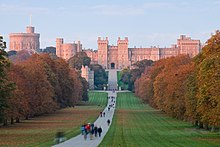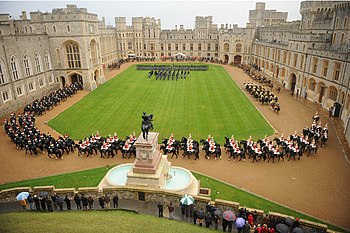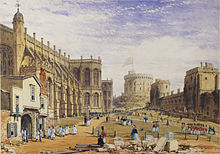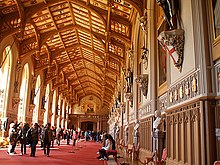Windsor Castle
Windsor Castle [ 'wɪnzə' kɑːsl ], in German also Windsor Castle , is located in the English city of Windsor and is the largest continuously inhabited castle in the world. Windsor Castle dates back to the time of William the Conqueror . The castle, along with the entire Windsor estate, is owned by the British Crown and is administered by the royal household. It is part of the Royal Collection while the Windsor estate is owned by the Crown Estate .
Along with Buckingham Palace and Holyrood Palace in Edinburgh, it is one of the main official residences of the British monarch . The castle is located in the town of Windsor in Berkshire, England. Below the castle, the Thames flows east to the capital, London . Windsor Castle is also known as the "English Versailles".
Windsor Castle is the official weekend residence of the Queen and is also used by Queen Elizabeth II for one month at Easter each year, while she spends the Christmas holidays at her private estate at Sandringham House and in August and September at Balmoral Castle in Scotland . On the occasion of her 80th birthday, the Queen moved her permanent residence to Windsor Castle and has since only worked three days a week (usually Tuesday to Thursday) at Buckingham Palace in London . Their presence can be recognized by the royal coat of arms standard on the Round Tower , while in their absence the Union Jack blows there.
Most of the kings and queens of England had a direct influence on the construction and development of the castle, which in their respective times served as a garrison, fortress, residence, official palace and sometimes as a prison. Today the buildings serve both as a museum and for state events as well as for the Queen's private purposes. The history of the castle and that of the British monarchy are inextricably linked; it can be traced chronologically through the reigns of the monarchs who owned it. When the country was at peace, large and sumptuous rooms were added to the castle. The castle was fortified more strongly during times of war. This pattern continues to this day.
Floor plan of the castle
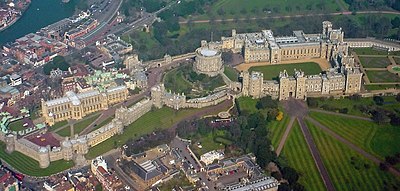

In its millennial history, the castle has changed and developed according to the preferred architectural styles, preferences, needs and financial capabilities of successive monarchs. The most important buildings of the castle are shown on the adjacent plan. Today's castle is still grouped around the Motte (A), an artificial mound. On this, William the Conqueror built the first wooden castle. The landmark of the castle, the round tower, which is visible from afar, is in reality not cylindrical in shape, but irregular. This is due to the actual shape of the man-made mound on which it was built. The layout of the castle evolved from the medieval fortifications. The round tower divides the castle into two different areas, the so-called courtyards. St George's Chapel (G ) is located in the lower courtyard (F) , while the private royal apartments (D) and the state apartments (C) are located in the upper courtyard (B). St George's Chapel is one of the finest examples of the Perpendicular Style in England.
The St. George Hall is one of the state apartments. This is a very large room, the ceiling of which is decorated with the coats of arms of the former and present knights of the Order of the Garter . The entrance to the state apartments is via the north terraces. Works by Michelangelo and Leonardo da Vinci can be seen in the painting exhibition and in the vestibule knight armor and the bullet through which Admiral Nelson was fatally wounded in 1805 during the battle of Trafalgar he victoriously led against Napoleon's fleet. In the Queen's Ball Room, visitors will find valuable paintings by Rembrandt , Peter Paul Rubens and Van Dyck . Next to Windsor Castle is Home Park, which is also home to Frogmore with the mausoleum of Queen Victoria and Prince Albert .
In the Curfew Tower (T) you can see the remains of the prison from the 13th century. A carillon sounds from the tower every three hours .
The Albert Memorial Chapel was originally built by Henry VII as a burial church, but he was buried in Westminster Abbey. Queen Victoria had the chapel converted into a memorial to him after the death of her husband Prince Albert in 1861.
History of the castle
founding
William the Conqueror bought the property from the monks of Westminster Abbey and from 1078 had a wooden castle built. The first stone houses were built under Heinrich I , his son.
Henry III. initiated the construction of the first modern fortifications, including the Zapfenstreich Tower ("Curfew Tower"). The 24 m high Round Tower was in the reign of Edward III. who was born here in 1312. He had the old castle torn down, which had been built under William the Conqueror, and arranged for the castle to be expanded into a residence, the layout of which has remained unchanged to this day.
Windsor Castle from 1350
King Edward III was born at Windsor Castle in 1312. He was therefore often called Edward of Windsor. From 1350 he began a 24-year renovation program in which he had the existing castle demolished except for the bell tower (T) and a few smaller outdoor facilities. He commissioned William von Wykeham with the renovation and redesign of the castle. The keep of Henry III. (the Round Tower) has been replaced by the currently preserved tower. It only got its current height in the 19th century. The fortifications were also further strengthened. The castle chapel was significantly expanded. However, plans to build a new church were not implemented. This was probably due to a lack of manpower and resources after the outbreak of the Black Death . The Norman Gate (M) also dates from this period. This large and awe-inspiring gate at the foot of the Round Tower is the last fortification in front of the Upper Court (B), around which the royal apartments are grouped.
In 1348 Edward III founded the Order of the Garter , the annual gathering of which is celebrated in St George's Chapel, the main chapel of the castle.
During the reign of Richard II in 1390, it was found that St. George's Chapel was in acute danger of collapsing. That is why it was renewed. The head of the work was one of Richard II's favorites, Geoffrey Chaucer . He served the king as a diplomat and as head of the royal building projects. Their close ties lasted throughout Richard II's reign. In the decade before Chaucer's death, Richard granted him several gifts and annuities, including a lifetime payment of £ 20 a year in 1394 and an annual delivery of 955 liters (252 gallons ) of wine in 1397 . Chaucer died on October 25, 1400. Whatever his skills as a technical expert and builder, within 50 years the chapel was again dilapidated.
King Edward IV (1461–1483), the first king of the House of York , was said to have been addicted to promoting vain pomp. He began the construction of St George's Chapel in its current form. In fact, the chapel, which was built in its current form from 1475, is more of a small version of a cathedral and a royal mausoleum . It is built in the perpendicular style . During the reign of Henry VII , part of the chapel was demolished to make room for the Lady Chapel , the construction of which was later canceled by the king. The chapel building was one of the first splendid architectural works on the castle grounds.
The construction of the chapel marked a turning point in the architecture of the castle. The more stable political climate after the end of the War of the Roses meant that the later expansions and conversions focused more on design and comfort, not, as before, on stronger fortifications. In this way, the character of the castle changed from a royal fortress to a royal palace. An example of this is the 1480 Horseshoe Cloister , which was built near the chapel to house the clergy. This curved brick building is said to have the shape of a horse's shackle. This was an Edward IV badge. Restoration work was undertaken in 1871 which removed most of the building materials originally used.
From the fortress to the palace
Edward III. was the monarch who began converting the castle from a fortress to a comfortable palace. Compared to the royal residences such as Whitehall and Nonsuch , however, Windsor remained inconspicuous. King Henry VIII (reign 1509–1547) rebuilt the main entrance to the palace (K) around 1510. He was placed in such a way that an attacker had to fight uphill after storming the gate. The coat of arms above the archway and the portcullis shows the pomegranate coat of arms of the first Queen Henry VIII, Catherine of Aragón .
The son and successor of Henry VIII, King Edward VI. , wrote as a boy during his stay in the castle: "I think I am in a prison here, there are neither galleries nor gardens to go for a walk here."
Edward VI's sister, Queen Elizabeth I (reign 1558–1603) spent most of her time at Windsor Castle and considered it the safest place in her kingdom. She withdrew here in times of tension. She assumed that the castle could withstand a siege if necessary. Although she apparently also viewed the castle as a fortress, she also helped transform it into a comfortable residence. So she had the north terrace prepared as a place for physical exercise and had a covered gallery built over it. This is an early example of a winter garden . The building has largely been preserved in its original form. It contains a huge fireplace from the Tudor period and now houses the royal library.
English Civil War
After Elizabeth I, James I succeeded the throne. After that, the government went to his son Charles I on. Neither of them undertook any significant renovation work on the castle. After Charles I was deposed, the palace became the headquarters for Oliver Cromwell's New Model Army . Windsor Castle fell to the parliamentary troops shortly after the outbreak of the civil war . This was thanks to the shrewdness of Colonel John Venn. Prince Ruprecht of the Palatinate arrived in Windsor a few days later to retake the city and the castle, but although he severely damaged the city in the bombardment, he was unable to take the castle. Venn remained the castle governor until 1645.
Under the control of parliamentary troops, the castle was damaged, but not as much as one would have expected for an emblematic symbol of the monarchy. However, the garrison stationed there was underpaid and allowed to loot royal valuables. During the Commonwealth of Nations , the castle remained the military headquarters and state prison for important captured royalists (royalists). Charles I was briefly imprisoned at Windsor Castle before his execution in 1649. By today's standards, this detention was more like house arrest. After the king's execution, Great Britain was ruled by Cromwell until the Restoration of the monarchy in 1660. The body of Charles I was smuggled into Windsor in a dark night during a snow storm, to be buried there without solemnity in a vault under the choir of St George's Chapel next to the coffins of Henry VIII and his wife Jane Seymour .
The restoration of the monarchy in 1660
After the restoration of the monarchy in 1660, Windsor Castle, which had remained unchanged for many years, was again significantly redesigned. Charles II put a lot of effort into repairing the damage to the castle that had occurred during the civil war and refurbishing it. At that time, Palace of Versailles was being built in France , and with that in mind, Charles II had The Long Walk (L) laid out. The avenue stands out south of the castle and is 4.8 km (3 miles) long and 80 m wide.The elms originally planted by the king on the sides have now been replaced by chestnuts and plane trees . The Long Walk isn't the only part that was inspired by the Palace of Versailles. Charles II commissioned the architect Hugh May to remodel the royal apartments and St. George's Hall. May replaced the original rooms from the time of the Plantagenets on the north terrace with the cube-shaped star building . These rooms are decorated with ceiling paintings by Antonio Verrio and carvings by Grinling Gibbons . The king also purchased tapestries and paintings to furnish the rooms. These works of art formed the basis for today's royal collection, the Royal Collection . Three of the rooms have remained largely unchanged: the queen's lounge and audience room, both designed for the wife of Charles II, Catherine of Braganza , and the king's dining room. Both the ceiling paintings by Verrio and the wall paneling by Gibbons have been preserved in these rooms. Originally there were twenty rooms with this equipment. Some of Gibbon's work was saved when changes were made as a result of renovations or restorations. In the 19th century, these carvings were then integrated into the new interior of the throne room of the Order of the Garter and into the Waterlook chamber.
The 18th and 19th centuries
After the death of Charles II in 1685, the preservation of the castle was neglected over time. While there were a number of inhabited royal buildings in the castle grounds and park, the monarchs preferred to live elsewhere themselves. During the reign of Wilhelm III. and Mary II (1689–1702), Hampton Court Palace was enlarged and converted into a massive modern palace. Queen Anne later preferred to live in a small house near the castle walls. It was not until 1804 that King George III. As the father of 13 children, he had a larger residence that could not be found anywhere else, so that the castle was fully inhabited again. The renovations from the time of Charles II reflected the classic architectural style that was popular at the time. Inigo Jones had in the days of Charles I the Palladian introduced in England. George III found this architectural style unsuitable for an ancient castle and had many of the windows from the time of Charles II provided with Gothic pointed arches . So the castle got its medieval appearance again. During this period, Windsor Castle again became a place of royal house arrest. In 1811, George III fell. into a state of permanent mental derangement and had to be locked in the castle for his own safety. During the last nine years of his life, he seldom left his rooms at Windsor Castle.
During the reign of George IV between 1820 and 1830, the most far-reaching renovations in the history of the castle took place. Known for its extravagant Carlton House and Royal Pavilion from the times of his reign, George IV persuaded Parliament to grant him £ 300,000 for the restoration. Architect Jeffry Wyatville was selected and work began in 1824.
The renovations took twelve years to complete and included a complete redesign of the Upper Court, the private apartments (D), the round tower (A) and the outer facade of the south wing (D). This gave the castle its almost symmetrical facade, as can be seen from the avenue of the Long Ganges.
Wyatville was the first architect to see the castle as a complete work, rather than a collection of different buildings from different eras and different architectural styles. As an architect, he preferred impressive symmetries, while the castle, as a product of centuries of development, initially showed no uniformity. Wyatville imposed a certain symmetry on this ensemble of buildings on the Upper Court by adding some towers to match others. He also gave the buildings at the Upper Court a gothic facade with a crenellated crown to match the medieval buildings. St George's Chapel in the lower courtyard was also redesigned in this way. The Round Tower had always been a squat building, and this impression was now reinforced by the new height of the buildings in the Upper Court. Wyatville overcame this problem by providing the Round Tower with a hollow stone crown, a kind of upper floor dummy. This dummy is 10 m high and gives the entire castle its dramatic silhouette, which is visible for many kilometers.
Most of the interior of the castle was also redesigned, as was the exterior. Many of the state apartments from the time of Charles II, which were built after the renovations under George III. Remnants have now been refurbished in the Gothic style. This particularly affected the St. George Hall, which was doubled in length. Wyatville also had a courtyard roofed over to create the Waterlookammer. This huge hall, lit with the help of cliffs , celebrated the victors of the Battle of Waterloo and was decorated with portraits of the allied monarchs who had destroyed Napoléon Bonaparte . 150 people can be seated at the large table in the middle of the chamber.
The work was still unfinished when George IV died in 1830, but it was completed almost at the same time as Wyatville's death in 1840.
Victorian era
Queen Victoria and Prince Albert made Windsor their main residence. Many of their changes affected the surrounding parking areas rather than the buildings. In particular, a law passed by Parliament in 1848 allowed the closure and rerouting of old paths that previously ran through Windsor Park towards Datchet and Old Windsor. These changes allowed the royal family to close much of the park to the public and create a private park. A mausoleum was built on the park grounds near Frogmore House , where Victoria and Albert are buried.
Queen Victoria retired to the seclusion of the castle after the death of her husband in 1861. From then until her death in 1901, the castle was her main residence, and she rarely visited Buckingham Palace . The prince's apartments were left exactly as they were when he died. And although a certain atmosphere of melancholy settled over the castle for the rest of the 19th century, some improvements and restorations were nevertheless carried out. In 1866, Anthony Salvin created the Grand Staircase in the State Apartments. The hall in which it is located is furnished with weapons and armor, including armor made by King Henry VIII in 1540. The upper steps are flanked by life-size horse statues with mounted knights in armor. This theme of decoration continues into the chamber of the guard and the queen's anteroom. Salvin also added the chateau-style conical roof tower to the bell tower (T).
The castle in the 20th century
After King Edward VII succeeded the throne in 1901, the castle was often uninhabited for long periods of time, as the king preferred his other palaces. The king came to Ascot during horse racing week and to Windsor at Easter. The layout of a golf course was one of the few changes he had made. Edward VII's successor, George V , who ruled from 1910 to 1936, also preferred his other country estates. However, his wife, Queen Maria , was a great art lover. Not only did she try to buy back parts of the palace's earlier fixtures that had previously been sold, but she also bought many new works of art to decorate the state apartments. She also reformed the use of the palace by abandoning the baroque notion that a large series of state chambers on the ground floor were reserved for the important guests. Instead, she had comfortable bedrooms set up on the upper floor so that the previously reserved rooms on the ground floor were now available for entertainment and court functions. The state bedroom itself was retained, but more out of historical interest. It has not been used as a bedroom since 1909.
During the First World War , the royal family saw a need to change their dynastic name. The German house of Saxe-Coburg-Gotha was renamed House Windsor after the castle . Queen Mary was known to be a lover of miniaturized things. Therefore, on the initiative of a cousin, a so-called doll's house was built for her in 1921-24, which was modeled on a large aristocratic house. It was created by the architect Lutyens . The furniture and pictures were made by leading craftsmen and designers of the 1920s. Queen Mary's Dolls' House is now one of the castle's many tourist attractions.
King George VI ascended the throne in 1936 after his brother's abdication. Edward VIII delivered his radio-broadcast abdication speech to the British Empire in one of the rooms of the palace. During his brief reign, however, he had preferred to live in his apartment at Fort Belvedere in Windsor Castle Park. George VI. and his consort, Queen Elizabeth , also preferred their previous apartment at the Royal Lodge in Windsor. When the Second World War broke out in 1939, the castle resumed its role as a royal fortress, and the royal couple and their children Princess Elisabeth and Princess Margaret lived at the castle for security reasons. The King and Queen drove to London daily and returned to Windsor to sleep. At the time, however, this was a well-kept secret, as it was reported for propaganda purposes and public morality that the King was staying at Buckingham Palace at all times. After the hostilities ended in 1945, the family left Windsor Castle and moved back into the Royal Lodge.
Queen Elizabeth II decided in 1952 to make Windsor her weekend retreat. To do this, she had the private apartments (D), which had not been continuously inhabited since the time of Queen Maria, renovated and further modernized.
On November 20, 1992, a fire broke out in the Queen's private chapel and spread rapidly. It was triggered by a halogen spotlight that lit a curtain. It raged for fifteen hours, destroying nine of the most important state apartments. Another 100 rooms were badly damaged. Overall, the buildings at the Upper Court were badly damaged. A fifth of the building area of the castle was damaged, a total of 9000 m² building area. The renovations took five years to complete. Seventy percent of the cost was raised by opening the State Apartments of Buckingham Palace to the public for the first time. The total cost of the repair was £ 37 million (EUR 50 million). The restoration was carried out so accurately that the difference between old and new is difficult to see. The private chapel, the lantern lobby and the new ceiling of the St. George's Hall have been redesigned in a historical style. The hall has been equipped with green oak , a technique that was already used in the Middle Ages. It is less evident that the restoration led to significant technical improvements, particularly in the arrangement of the public spaces and service rooms. Only a small notice board at the place where the fire broke out informs the visitor about the fire.
safety
The security of the palace is mainly ensured by the Thames Valley Police and a department of the London Metropolitan Police, which is responsible for the protection of the royal family and diplomats. In addition, battalions of the Foot Guards of the Household Division and the Victoria Barracks in Windsor are on duty as part of the Windsor Palace Guard.
Important events
- Marriage of Henry I and Adelheid von Löwen , his second wife (1121)
- Birth of King Edward III. (1312)
- Marriage of Edward of Woodstock and Joan of Kent (1361)
- Burial of King Edward IV (1483)
- Marriage of King Edward VII and Alexandra of Denmark (1863)
- Death of Canadian Prime Minister John Thompson (1894)
- Fire of the castle (1992)
- Marriage of Prince Edward, Earl of Wessex and Sophie Rhys-Jones , Countess of Wessex (1999)
- Death of Elizabeth Bowes-Lyon ( the Queen Mother ) (30 March 2002)
- Marriage of Charles, Prince of Wales , and Camilla Parker Bowles , Duchess of Cornwall (April 9, 2005)
- Marriage of Harry, Duke of Sussex , and Meghan, Duchess of Sussex (May 19, 2018)
- Death of Prince Philip, Duke of Edinburgh , Prince Consort of Queen Elizabeth II (April 9, 2021)
- Funeral of Prince Philip, Duke of Edinburgh (April 17, 2021)
literature
- Raymond South: The Book of Windsor. The Story of a Royal Town. Barracuda Books, Chesham 1977, ISBN 0-86023-038-4 .
- Neville Williams: Royal Homes of Great Britain. From medieval to modern Times. Lutterworth Press, London 1971, ISBN 0-7188-0803-7 .
- Barrington J. Hill: Windsor Castle. The history and treasures of Windsor Castle . Pitkin Pictorials, London 1972, ISBN 0-85372-012-6 .
Web links
- Official website (English)
- Windsor Castle as a 3D model in SketchUp's 3D warehouse
- http://www.royalcollection.org.uk/about/administration
- http://www.royal.gov.uk/TheRoyalResidences/WindsorCastle/WindsorCastle.aspx
Coordinates: 51 ° 29 ′ 2 " N , 0 ° 36 ′ 15.8" W.
